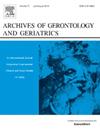英国老年人 14 年来孤独和社会隔离与多病症的关系:一项基于人口的队列研究。
IF 3.5
3区 医学
Q2 GERIATRICS & GERONTOLOGY
引用次数: 0
摘要
背景:以前的纵向研究将多重疾病与孤独(感觉疏离)和社会隔离(减少社会接触)联系起来。然而,随着时间的推移,这些联系的性质尚不清楚。目的:在一组年龄≥50岁的具有全国代表性的成人队列中,通过14年的随访,研究多病与孤独和社会隔离的双向关联。方法:本回顾性队列研究使用了英国老龄化纵向研究中成年人的七波数据(收集于2004/2005年至2018/2019年)。多重发病定义为存在≥2个长期条件。孤独感是用加州大学洛杉矶分校(UCLA)的3项量表来测量的。社会孤立是根据同居状况、与孩子、亲戚和朋友接触的频率以及社会组织成员资格得出的。我们使用Cox比例风险模型,对社会隔离或孤独、人口统计学和健康行为变量进行了调整。结果:该队列包括6031名成年人,他们有孤独感、社会隔离、多病和其他协变量的基线和随访数据。孤独与多发病风险增加相关[aHR (95% CI): 1.38(1.15-1.65)],而社会孤立与此无关[aHR (95% CI): 0.97(0.81-1.16)]。多重发病与偶发性孤独风险增加相关[aHR (95% CI): 1.55(1.30-1.84)],但与随后的偶发性社会孤立风险无显著相关[aHR (95% CI): 1.09(0.92-1.28)]。结论:孤独与多重疾病之间存在独立的双向关联。针对孤独的干预措施可以预防或延迟多重疾病,也可以改善多重疾病患者的福祉。本文章由计算机程序翻译,如有差异,请以英文原文为准。
The association of loneliness and social isolation with multimorbidity over 14 years in older adults in England: A population-based cohort study
Background
Previous longitudinal studies have linked multimorbidity to loneliness (feeling alienated) and social isolation (having reduced social contact). However, the nature of these associations over time is unclear.
Objective
To examine bidirectional associations of multimorbidity with loneliness and social isolation over a 14-year follow-up in a nationally representative cohort of adults aged ≥ 50 years.
Methods
This retrospective cohort study used seven waves of data (collected between 2004/2005 and 2018/2019) from adults in the English Longitudinal Study of Ageing. Multimorbidity was defined as the presence of ≥2 long-term conditions. Loneliness was measured using the 3-item University of California Los Angeles (UCLA) scale. Social isolation was derived based on cohabitation status, frequency of contact with children, relatives, and friends, and social organisation membership. We used Cox proportional hazards models adjusted for social isolation or loneliness, demographic and health behaviour variables.
Results
The cohort consisted of 6031 adults with baseline and follow-up data on loneliness, social isolation, multimorbidity, and other covariates. Loneliness was associated with increased risk of incident multimorbidity [aHR (95 % CI): 1.38 (1.15–1.65)], whereas social isolation was not [aHR (95 % CI): 0.97 (0.81–1.16)]. Multimorbidity was associated with increased risk of incident loneliness [aHR (95 % CI): 1.55 (1.30–1.84)], but not significantly associated with subsequent risk of incident social isolation [aHR (95 % CI): 1.09 (0.92–1.28)].
Conclusions
An independent bidirectional association exists between loneliness and multimorbidity. Interventions targeting loneliness may prevent or delay multimorbidity and also improve wellbeing for people with multimorbidity.
求助全文
通过发布文献求助,成功后即可免费获取论文全文。
去求助
来源期刊
CiteScore
7.30
自引率
5.00%
发文量
198
审稿时长
16 days
期刊介绍:
Archives of Gerontology and Geriatrics provides a medium for the publication of papers from the fields of experimental gerontology and clinical and social geriatrics. The principal aim of the journal is to facilitate the exchange of information between specialists in these three fields of gerontological research. Experimental papers dealing with the basic mechanisms of aging at molecular, cellular, tissue or organ levels will be published.
Clinical papers will be accepted if they provide sufficiently new information or are of fundamental importance for the knowledge of human aging. Purely descriptive clinical papers will be accepted only if the results permit further interpretation. Papers dealing with anti-aging pharmacological preparations in humans are welcome. Papers on the social aspects of geriatrics will be accepted if they are of general interest regarding the epidemiology of aging and the efficiency and working methods of the social organizations for the health care of the elderly.

 求助内容:
求助内容: 应助结果提醒方式:
应助结果提醒方式:


